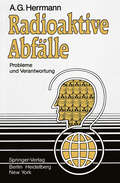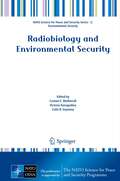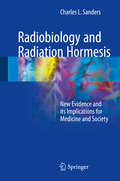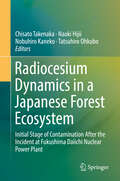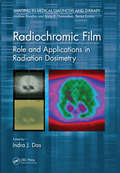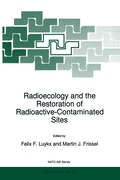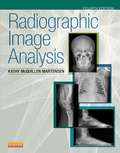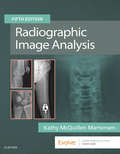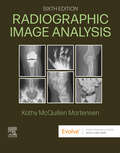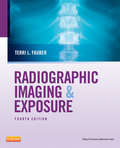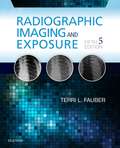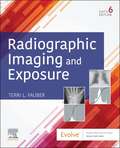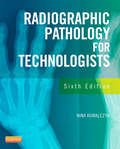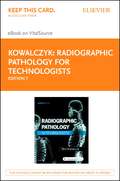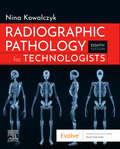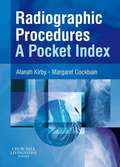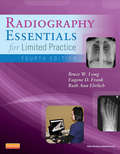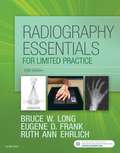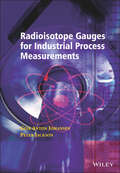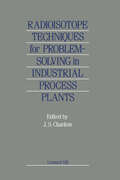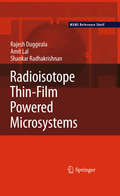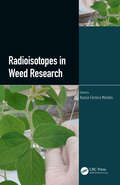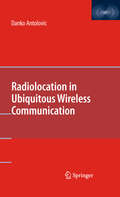- Table View
- List View
Radiobiology and Environmental Security (NATO Science for Peace and Security Series C: Environmental Security)
by Carmel E. E. Mothersill, Victoria Korogodina and Colin B. B. SeymourThis volume – like the NATO Advanced Research Workshop on which it is based – addresses the fundamental science that contributes to our understanding of the potential risks from ecological terrorism, i.e. dirty bombs, atomic explosions, intentional release of radionuclides into water or air. Both effects on human health (DNA and systemic effects) and on ecosystems are detailed, with particular focus on environmentally relevant low-dose ranges. The state-of-the-art contributions to the book are authored by leading experts; they tackle the relevant questions from the perspectives of radiation genetics, radiobiology, radioecology, radiation epidemiology and risk assessment.
Radiobiology and Radiation Hormesis: New Evidence and its Implications for Medicine and Society
by Charles L. SandersThis book presents new information on radiobiology that more clearly refutes the linear no-threshold (LNT) assumption and supports radiation hormesis. Fresh light is cast on the mechanisms of radiation hormesis and the potential benefits of low-dose ionizing radiation in preventing and treating a wide variety of inflammatory and proliferative diseases. It is proposed that these effects may derive from cellular communication via electromagnetic waves directed by DNA, with each cell acting as a quantum computer. Readers will also find close analysis of the negative impacts of radiophobia on many aspects of modern life, including attitudes to imaging technologies, licensing of nuclear power reactors, and preparedness for survival of nuclear war. The book will be of interest to researchers and scientists in radiobiology, radiation protection, health physics, medical physics, and radiology. Specifically, it will provide medical physicians, radiation oncologists, radiation epidemiologists, gerontologists, cell biologists, toxicologists, and nuclear engineers with a wide range of interesting facts and enlightening novel perspectives.
Radiocesium Dynamics in a Japanese Forest Ecosystem: Initial Stage of Contamination After the Incident at Fukushima Daiichi Nuclear Power Plant
by Chisato Takenaka Naoki Hijii Nobuhiro Kaneko Tatsuhiro OhkuboThis book investigates radiocesium movement in all major components of forest ecosystems, e.g. the plants, animals, insects, microorganisms, and soils, during the initial stage of contamination after the incident at Fukushima Daiichi Nuclear Power Plant. Most of the work was conducted at a common research site.More specifically, the book examines the contribution of surface uptake by trees in the dynamics of radiocesium during the initial contamination stage; the movement of radiocesium in the form of small organic fragments that are essential to the radiocesium dynamics in forest ecosystems; and the upward movement of radiocesium due to microorganism activity, which promotes the effective decontamination of the forest floor. Lastly, it explains why spiders could be a valuable indicator of the contamination level in forest ecosystems.
Radiochromic Film: Role and Applications in Radiation Dosimetry (Imaging in Medical Diagnosis and Therapy)
by Indra J. DasThis book provides a first authoritative text on radiochromic film, covering the basic principles, technology advances, practical methods, and applications. It focuses on practical uses of radiochromic film in radiation dosimetry for diagnostic x-rays, brachytherapy, radiosurgery, external beam therapies (photon, electron, protons), stereotactic body radiotherapy, intensity-modulated radiotherapy, and other emerging radiation technologies. The expert authors address basic concepts, advantages, and the main applications including kilovoltage, brachytherapy, megavoltage, electron beam, proton beam, skin dose, in vivo dosimetry, postal and clinical trial dosimetry. The final chapters discuss the state of the art in microbeam, synchrotron radiation, and ultraviolet radiation dosimetry.
Radiochromic Film: Role and Applications in Radiation Dosimetry (Imaging in Medical Diagnosis and Therapy)
by Indra J. DasThis book provides a first authoritative text on radiochromic film, covering the basic principles, technology advances, practical methods, and applications. It focuses on practical uses of radiochromic film in radiation dosimetry for diagnostic x-rays, brachytherapy, radiosurgery, external beam therapies (photon, electron, protons), stereotactic body radiotherapy, intensity-modulated radiotherapy, and other emerging radiation technologies. The expert authors address basic concepts, advantages, and the main applications including kilovoltage, brachytherapy, megavoltage, electron beam, proton beam, skin dose, in vivo dosimetry, postal and clinical trial dosimetry. The final chapters discuss the state of the art in microbeam, synchrotron radiation, and ultraviolet radiation dosimetry.
Radioecology and the Restoration of Radioactive-Contaminated Sites (NATO Science Partnership Subseries: 2 #13)
by Felix F. Luykx, Martin J. FrisselMost of the nuclear facilities built since the Second World War have ceased active operation and have been decommissioned. Some of the sites are heavily contaminated with radioactive substances. Correct and efficient action to mitigate the radiological consequences of such contamination will only be possible when the behaviour of radionuclides in the terrestrial environment is sufficiently well known. Yet radioecologists often find it difficult to study the transfer of radioactivity in agricultural land and semi-natural ecosystems, because of the complexity and diversity of such environments. The present book presents an analysis of all the factors that affect the behaviour of radionuclides as they move from their point of release through the environment and then enter the tissues of biota living in the ecosystems, in particular plants and animals consumed by humans. The course on which the book is based was held in a region that is heavily contaminated by radioactive discharges into the environment during nuclear weapons fabrication in the 1950s and '60s, and due to a severe accidental release following the explosion of a rad-waste tank in 1957. This allowed in situ training of the students. The book's main emphasis is on specific radioecological problems in severely contaminated areas in the former Soviet Union: the Southern Urals Trail, the rivers Techa-Isert-Tobol-Irtis-Ob, and the 30 km zone around Chernobyl. Systems examined include soils, arable and pasture land, forests, lakes and rivers. Special attention is paid to the effects of radiation on natural ecosystems: trees, soil-dwelling organisms, and aquatic organisms. Synergistic effects are also considered. Short, medium and long term countermeasures are discussed.
Radiographic Image Analysis - E-Book
by Kathy McQuillen MartensenLearn to produce the most accurate radiographic images on the first try with Radiographic Image Analysis, 4th Edition. This thoroughly updated guide walks you through the steps of how to carefully evaluate an image, how to identify the improper positioning or technique that caused a poor image, and how to correct the problem. For each procedure, there is a diagnostic-quality radiograph along with several examples of unacceptable radiographs, a complete list of radiographic evaluation guidelines, and detailed discussions on how each of the evaluation points is related to positioning and technique. Each unacceptable radiograph is accompanied by a description of the misaligned anatomical structures, how the patient was mis-positioned, and how to adjust technique to obtain an acceptable radiograph. "The whole text is well presented." Reviewed by Jenny May on behalf of Radiography, July 2015Poorly positioned example images appear at the end of procedures to test your knowledge.Spotlights concepts boxes highlight the most important information as it appears in the chapters and directs readers to more information on these topics. Chapter objectives, key terms, and outlines help in mastering important concepts and information.NEW! Expanded sections on pediatric, obesity, and trauma digital radiography provides the most pertinent and up-to-date information needed for clinical success.NEW! Reformatted content surrounding procedures includes the following to help you identify correctly and incorrectly positioned patients: accurately positioned projection with labeled anatomyphotograph of an accurately positioned modeltable that provides a detailed one-to-one correlation between the positioning procedures and image analysis guidelinesdiscussion, with correlating images, on identifying how the patient, central ray, or image receptor were poorly positioned if the projection does not demonstrate an image analysis guidelinediscussion of topics relating to positioning for patient condition variations and non-routine situationsphotographs of bones and models positioned as indicated to clarify information and demonstrate anatomy alignment when distortion makes it difficultpractice images of the projection that demonstrate common procedural errorsNEW! Two-color design helps you read and retain pertinent information.NEW! Updated boxed material summarizes important analysis details and provides a quick reference.NEW! Highlighted table data offers a new format to aid in the understanding of field size requirements using direct-capture digital radiography.
Radiographic Image Analysis E-Book
by Kathy McQuillen MartensenLearn to produce quality radiographs on the first try with Radiographic Image Analysis, 5th Edition. This updated, user-friendly text reflects the latest ARRT guidelines and revamped chapters to reflect the latest digital technology. Chapters walk you through the steps of how to carefully evaluate an image, how to identify the improper positioning or technique that caused a poor image, and how to correct the problem. For each procedure, there is a diagnostic-quality radiograph along with several examples of unacceptable radiographs, a complete list of radiographic evaluation guidelines, and detailed discussions on how each of the evaluation points is related to positioning and technique. It’s everything you need to critically think, evaluate, and ultimately produce the best possible diagnostic quality radiographs.Chapter objectives, key terms, and outlines reinforce what is most important in every chapter.Bold and defined key terms at first mention in the text ensure that you understand the terms from the start of when they are used in discussions. Expanded glossary serves as a quick reference and study tool. Two-color text design makes it easier to read and retain pertinent information.NEW! Updated content reflects the latest ARRT guidelines.NEW! Revamped sections on digital imagery within pediatric, obesity, and trauma situations incorporate the latest technology.NEW! Additional images offer further visual guidance to help you better critique and correct positioning errors.NEW! More robust digital halftones throughout images paint a clearer picture of proper technique.
Radiographic Image Analysis - E-Book: Radiographic Image Analysis - E-Book
by Kathy McQuillen-MartensenGain the knowledge and skills you need to analyze radiographic images and solve imaging challenges! Reflecting the latest ARRT® content specifications, Radiographic Image Analysis, 6th Edition provides a guide to evaluating and adjusting images to produce diagnostic-quality radiographs. It helps you to identify the error in positioning or technique that may have caused a poor image, then shows how to correct the problem, so you can reduce the need for repeat radiographs. Each projection includes an optimal radiograph along with examples of unacceptable images. Written by radiology expert Kathy McQuillen Martensen, this text builds your critical thinking skills and helps you prepare for success on the ARRT certification examination. Chapter objectives, key terms, outlines, and summaries reinforce the most important material. Image analysis guidelines for each procedure include accurately positioned projections with labeled anatomy, photographs of accurately positioned models, discussions of poor positioning and of positioning variations, practice projections that demonstrate common procedural errors, and more. Questions to Consider help you thoroughly analyze projections. Spotlights highlighting Concepts boxes emphasize the most important information and direct readers to additional information on these topics. Review questions at the end of chapters help you assess your understanding of the material, with answers provided on the Evolve website. Summary tables provide quick access to important data for easy reference. Bolded key terms are defined in the expanded glossary, ensuring that you understand the terms under discussion. NEW! Additional images help you to evaluate and correct positioning errors, and other images are replaced with more robust digital halftones. NEW! Revamped chapters on digital imaging incorporate the latest technology. NEW! Updates reflect the latest ARRT® content specifications.
Radiographic Imaging and Exposure - E-Book
by Terri L. FauberWith comprehensive coverage of both digital radiography and conventional film-screen radiography, RADIOGRAPHIC IMAGING AND EXPOSURE, 4th Edition helps you master the fundamental principles of imaging, produce clear images, and reduce the number of repeat radiographs. This practical text also includes Important Relationship, Mathematical Application, and Patient Protection Alert features throughout to provide helpful information every step of the way. Comprehensive coverage of both digital radiography and conventional film-screen radiography helps students and radiographers master the fundamental principles of imaging, produce clear images, and reduce the number of repeat radiographs. UNIQUE! Integrated digital radiography coverage includes information on how to acquire, process, and display digital images. UNIQUE! Patient Protection Alerts highlight the variables that impact patient exposure and how to control them. UNIQUE! Important Relationships boxes call attention to the fundamentals of radiographic imaging and exposure. UNIQUE! Mathematical Applications boxes familiarize you with the mathematical formulas needed in the clinical setting. NEW! Updated information reflects the latest advances in digital imaging, fluoroscopy, and the X-ray beam with added x-ray emission graphs. NEW! Image receptor and image acquisition coverage describes the construction of image receptors and how the latent (invisible) image is captured, and addresses the advantages and limitations of digital vs. conventional imaging processes. NEW! Image Evaluation chapter allows you to practice applying what you’ve learned about image quality and exposure technique factors.
Radiographic Imaging and Exposure - E-Book
by Terri L. FauberGet a head start in producing quality images and fewer repeat radiographs with Fauber’s Radiographic Imaging and Exposure, 5th Edition. Covering both digital radiography and film-screen radiography, this practical text is the key to mastering the fundamentals of imaging, passing the ARRT certification exam, and becoming a successful radiography professional. Along with the radiography protection alerts, mathematical applications, and concise writing style retained from the last edition, this new edition features updated content reflecting the latest ARRT and ASRT content, expanded coverage of digital fluoroscopy, and enhanced content on problem-solving in situations of poor-quality radiographs.Extensive digital radiography coverage helps readers learn to acquire, process, and display digital images while discussing the advantages and limitations of digital vs. film processes.Concentration on imaging and exposure lays the groundwork for becoming a competent radiographer.Radiation Protection alerts highlight the variables that impact patient exposure and how radiographers can control them.Important Relationships sections recap the relationships among concepts being discussed, calling attention to how they relate to one another. Mathematical Applications sections show how mathematical concepts and formulas are applied in the clinical setting.Straightforward and concise writing style makes the content understandable and accessible. Review questions are provided for every chapter with answers in the back of book.Bulleted summaries at the ends of chapters offer a quick review of the key concepts just covered in the chapter.Appendices provide an easy-to-use format for quick reference and studying important concepts and formulas.Glossary of key terms serves as a quick reference for key terms covered throughout the book.NEW! Expanded coverage of digital fluoroscopy including up-to-date information on LCD and Plasma displays provide a better understanding of the latest professional equipment.NEW! Revised content on image evaluation covers both film and digital along with problem-solving scenarios for poor quality and recommendations for improvement.NEW! Updated content reflects the latest content outlined by the ARRT and ASRT.
Radiographic Imaging and Exposure - E-Book
by Terri L. FauberMaster the radiography skills needed to produce high-quality images every time! With straightforward coverage of imaging principles, Radiographic Imaging and Exposure, 6th Edition describes exposure techniques and how to acquire, process, and display digital images. Not only does this book help you reduce the need for repeat images, it includes problem-solving guidelines for troubleshooting situations. Written by noted educator Terri L. Fauber, this book also provides the essential knowledge needed to pass the ARRT certification exam.Extensive digital radiography coverage explains how to acquire, process, and display digital images, along with important aspects of data management.Straightforward focus on imaging and exposure provides the knowledge you need to become a competent radiographer. Concise, easy-to-understand writing style makes the content easily accessible.Patient Protection Alerts highlight the variables that impact patient exposure and how radiographers can control them.Relationships sections summarize the connections between radiographic concepts, calling attention to how they relate to one another. Mathematical Applications sections show how mathematical concepts and formulas are applied in the clinical setting.Bulleted summaries at the ends of chapters offer a quick review of key concepts.Review questions are provided in every chapter, with answers in the back of the book.Convenient appendixes include Important Relationships, Mathematical Applications, and Patient Protection Alerts, providing a quick reference to important concepts and formulas.Glossary of key terms defines need-to-know terminology covered throughout the book.NEW! Coverage of digital imaging includes two chapters with expanded image processing and new content on data management.NEW! Updated content reflects the newest curriculum standards outlined by the ARRT and ASRT, and provides everything you need to prepare for the boards and for clinical success.NEW! Additional digital images are included in the digital imaging chapters, as well as the Scatter Control and Exposure Technique Selection chapters.NEW! Expanded coverage of digital fluoroscopy includes a thorough explanation of fluoroscopic operational features that impact the patient dose in Dynamic Imaging: Fluoroscopy chapter.
Radiographic Pathology for Technologists - E-Book
by Nina KowalczykRadiographic Pathology for Technologists, 6th Edition concisely covers the injuries and abnormalities most frequently diagnosed using medical imaging to prepare you for what you are most likely to encounter on the job. This essential text also features background discussions of key anatomy and physiology principles, along with imaging considerations for each disease categorized by type followed by a description of its radiographic appearance, signs and symptoms, and treatment.Concise coverage presents approximately 150 injuries and abnormalities most frequently diagnosed using medical imaging to keep you focused on what you are most likely to encounter in practice.Correlative and differential diagnosis discussions explain the diagnostic process and demonstrate the importance of high quality images.Chapter outlines and objectives, key terms, and multiple choice and discussion questions for each chapter with answers provided in the back of the text highlight the most important concepts within each chapter.Summary tables at the end of each chapter list pathologies covered and the preferred imaging modalities for diagnosis.Trauma chapter emphasizes the multi-system implications of traumatic injuries.NEW! Replacement images and illustrations reflect current practice for general radiography and alternative modalities, such as CT, MR, and fusion imaging.NEW! Updated coverage of digital radiography gives you the most up-to-date information on 3-D reconstructions, PET imaging, molecular imaging, monoclonal antibody technology, advances in cardiac imaging, and fusion technologies.NEW! Information on the Human Genome Project in introductory chapter reflects advances in molecular medical leading to more personalized treatment of disease. NEW! Virtual endoscopic images in GI chapter illustrate the latest in endoscopic imaging techniques.NEW! Coverage of interventional procedures in hepatobiliary and urinary systems help you diagnose and treat patients using the least invasive techniques.NEW! Expansion of neoplastic disease content in respiratory system chapter highlights the important role radiographic pathology plays in diagnosis and treatment.
Radiographic Pathology for Technologists - E-Book
by Nina KowalczykUsing an essentials approach, Radiographic Pathology for Technologists, 7th Edition concisely covers the injuries and abnormalities most frequently encountered in practice. This new edition has been updated to reflect the latest ACR appropriateness criteria and ASRT curriculum guidelines. It also features background discussions of key anatomy and physiology principles, along with imaging considerations for each disease categorized by type followed by a description of its radiographic appearance, signs and symptoms, and treatment.Essential level of coverage presents approximately 150 injuries and abnormalities most frequently diagnosed using medical imaging.Summary tables at the end of each chapter list pathologies covered and the preferred imaging modalities for diagnosis.Correlative and differential diagnosis discussions explain the diagnostic process and demonstrate the importance of high quality images.Chapter outlines and objectives, key terms, and multiple choice and discussion questions for each chapter with answers provided in the back of the text highlight the most important concepts within each chapter. NEW! Updated content reflects the latest ACR Appropriateness criteria and ASRT curriculum guidelines. NEW! Current digital radiography practices and images covered throughout text. NEW! Radiographic images illustrate gastrointestinal, hepatobiliary, and urinary pathologiesNEW! Replacement images and illustrations reflect current practice for general radiography and alternative modalities, such as CT, MR, and fusion imaging to help you understand how pathologies are demonstrated.
Radiographic Pathology for Technologists, E-Book
by Nina KowalczykGet the essential information you need to master radiographic pathology! Radiographic Pathology for Technologists, 8th Edition introduces the pathologic appearance of common diseases as seen in diagnostic imaging. Organized by body system, the book uses a clear, easy-to-understand approach to discuss anatomy and physiology, the pathologic process, signs and symptoms, diagnosis, and treatment of diseases. This edition is updated to reflect today’s radiography practice including diagnostic modalities such as CT, MR, sonography, nuclear medicine, and fusion/hybrid imaging. From well-known radiologic and imaging sciences author Nina Kowalczyk, this essential text also provides excellent preparation for the radiographic pathology portion of the ARRT® credentialing exam. Essential level of coverage presents approximately 150 injuries and abnormalities most frequently diagnosed using medical imaging, focusing students on the pathologies they are most likely to encounter in practice and providing just the right amount of information for a shorter pathology course. Discussions of correlative and differential diagnosis explain the diagnostic process and demonstrate the importance of high-quality images. Summary tables review the pathologies covered and the preferred imaging modalities for diagnosis. Learning features include chapter outlines and objectives, key terms, and multiple-choice and discussion questions for each chapter, with answers provided in the back of the text. NEW! Updated content reflects the latest ARRT and ASRT curriculum guidelines. NEW! Current digital radiography is covered throughout the text. NEW! Updated images and illustrations reflect current practice for general radiography and alternative modalities such as CT, MR, sonography, nuclear medicine, and fusion/hybrid imaging, demonstrating how pathologies appear in various imaging modalities.
Radiographic Procedures: A Pocket Index E-Book
by Alanah Kirby Margaret CockbainThis book gives a quick reference to plain radiological examinations and commonly performed contrast studies. It aids decision-making by providing information on the advantages and relevance of each technique, and by indicating any additional modalities currently being used.Pocket-sized to enable it to be carried in the pocket of a uniform.Alphabetical presentation allows for a speedy search facility with cross-referencing to related techniques.Diagrams provide visual assistance with patient position, surface anatomy and three dimensional planes of the body.Medical prefixes and suffixes will help trace the derivation of unknown words.Abbreviations listed to provide familiarity and help with the interpretation of related procedures.
Radiography Essentials for Limited Practice - E-Book
by Bruce W. Long Eugene D. Frank Ruth Ann EhrlichThe ONLY textbook written for limited radiography students, this book makes it easy to understand and perform basic procedures. It incorporates all the subjects mandated by the American Society of Radiologic Technologists (ASRT) curriculum, so you will be thoroughly prepared for the ARRT Limited Scope Exam. Coverage includes the latest information on x-ray science and techniques, processing, radiation safety, radiographic anatomy, patient care, and pathology, along with step-by-step instructions for positioning.Thorough preparation for the ARRT Limited Scope Exam and clinical practice is a key focus of this title.Concise coverage incorporates all of the content mandated by the ASRT Core Curriculum for Limited X-ray Machine Operators.The latest information on state licensure and limited radiography terminology ensures you understand the role of the limited practitioner.Topics include x-ray science and techniques; radiation safety; radiographic anatomy, pathology, and positioning of upper and lower extremities, spine, chest and head; patient care; and ancillary clinical skills.Over 1,000 anatomy illustrations, positioning photos, and x-rays teach anatomy and demonstrate patient positioning and the resulting x-rays in detail.Math and radiologic physics concepts are presented in a easy-to-follow way. Bone densitometry chapter provides all the information needed to perform bone densitometry exams and to pass the ARRT bone densitometry certification exam.Step-by-step instructions for positioning the patient for the radiographic procedures performed by limited operators. EXPANDED! Digital imaging concepts reflect current practice and meet the requirements of the ASRT Limited Scope Content Specifications.NEW! The most common podiatric and chiropractic radiography procedures have been added for practitioners working in states that have limited podiatric or chiropractic license categories. NEW! Updated drawings, photos, and medical radiographs enhance understanding of key concepts and illustrate current technology. UPDATED! Patient care section now includes discussions of mechanical lifts and safe storage of chemicals, as well as a table of normal pediatric and adult vital signs.
Radiography Essentials for Limited Practice - E-Book
by Bruce W. Long Eugene D. Frank Ruth Ann EhrlichWritten exclusively for limited radiography students, Radiography Essentials for Limited Practice, 5th Edition makes it easy to learn and perform basic procedures. This edition has been revised to improve information clarity and reflect changes in practice. It incorporates all the subjects mandated by the American Society of Radiologic Technologists (ASRT) curriculum, so you will be thoroughly prepared for the ARRT Limited Scope Exam. Coverage includes the latest information on x-ray science and techniques, processing, radiation safety, radiographic anatomy, patient care, and pathology, along with updated step-by-step instructions for positioning and procedures. Concise coverage thoroughly prepares you for the ARRT Limited Scope Exam and clinical practice with the latest on x-ray science and techniques, radiation safety, radiographic anatomy, pathology, patient care, ancillary clinical skills, and positioning of upper and lower extremities, spine, chest and head.Step-by-step instructions provide guidance on how to position patients for radiographic procedures performed by limited operators. The latest information on state licensure and limited radiography terminology ensures that you understand the role of the limited practitioner.Math and radiologic physics concepts are presented at an easy-to-understand level. Chapter on Bone Densitometry provides all the information you need to know to for the ARRT exam and clinical practice. NEW! Expanded digital imaging concepts reflect current practice and meet the requirements of the ASRT Limited Scope Content Specifications.NEW! Updated drawings, photos, and medical radiographs enhance your understanding of key concepts and illustrate current technology. NEW! Two-color design helps make complex material easier to comprehend.
Radioisotope Gauges for Industrial Process Measurements
by Geir Anton Johansen Peter JacksonIn order to fully utilise nucleonic measurement principles andtheir applications, it is important to have an understanding of theunderlying physics. Radioisotope Gauges for Industrial ProcessMeasurements combines theoretical background with practicalexperience in order to present an accessible overview of the use ofradioisotopes in industry. This unique book explains the modes ofoperation of installed gauges and presents nucleonic methodsrelevant to measurement problems. The first part of the book dealswith radiation sources, the interaction of radiation with matterand radiation detectors. The second part explains the differentmeasurement principles used for industrial gauges and the last partof the book covers industrial applications. This book also: * Features a concise introduction to atomic and nuclearphysics. * Presents a range of nucleonic measurement methods andhighlights their application to a variety of problems. * Contains an overview of electronics, measurement accuracy,safety and standards. * Considers processes and demands, design strategies andpractical realisation of measurement systems. * Provides many practical engineering examples. Offering a comprehensive coverage of engineering applications,this book is an essential tool for electrical, electronic andinstrument engineers in the oil and chemicals processing sectors.It is also a valuable reference to graduate students and physicistsinvolved in nuclear radiation measurement, medical applications,radiochemical research, environmental monitoring and chemicalengineering.
Radioisotope Thin-Film Powered Microsystems (MEMS Reference Shelf #6)
by Rajesh Duggirala Amit Lal Shankar Radhakrishnan“Radioisotope Thin-Film Powered Microsystems” describes high energy density microbatteries required for compact long lifetime wireless sensor Microsystems. These microbatteries are presented alongside theories employing high energy density radioisotope thin films in actuating novel electromechanical energy converters. Also discussed are novel wireless sensor architectures that enable long lifetime wireless sensors Microsystems with minimal amounts of radioisotope fuel used. Ultra low-power beta radiation counting clocks are described in order to illustrate the application of radioisotope thin films in realizing the deployment of various components of Microsystems. “Radioisotope Thin-Film Powered Microsystems” also presents the latest work on 3D silicon electrovoltaic converters and energy density microbatteries required for high-power Microsystems.
Radioisotopes in Weed Research
by Kassio Ferreira MendesHerbicides are of great importance in weed management and are one of the most widely used pesticide groups for weed control across the globe. Concerns around the residual effects of these intensively used chemicals are equally widespread. Offering a new direction for research that focuses on herbicide behavior and its impacts on the environment, this book covers the use of radioisotopes in weed research and the detoxification of herbicides. Applying technological advances in radiation detection, Radioisotopes in Weed Research explains how isotopic techniques can be used to identify degradation products and trace the fate of herbicides applied to crop plants. This book provides essential information on the historical use and recent advances of radioisotopes in weed research. It demonstrates the potential these methods offer the field of weed science in gaining a better understanding of the behavior of herbicides in plants and soil and working to ensure the continuous, effective, and safe use of herbicides, minimizing harmful impacts on ecosystems. Features: Explains the radiometric method with studies of radiolabelled herbicides and includes case studies as examples Describes radiometric methods to study the behavior of herbicides in soil from transport and transformation to retention Elucidates the absorption, translocation, and metabolism studies of herbicides in plants Authored by a team of leading scientists, this book is written for professors, researchers, extensionists, graduate and undergraduate students, rural producers, and other professionals involved in weed science.
Radioisotopes in Weed Research
by Kassio Ferreira MendesHerbicides are of great importance in weed management and are one of the most widely used pesticide groups for weed control across the globe. Concerns around the residual effects of these intensively used chemicals are equally widespread. Offering a new direction for research that focuses on herbicide behavior and its impacts on the environment, this book covers the use of radioisotopes in weed research and the detoxification of herbicides. Applying technological advances in radiation detection, Radioisotopes in Weed Research explains how isotopic techniques can be used to identify degradation products and trace the fate of herbicides applied to crop plants. This book provides essential information on the historical use and recent advances of radioisotopes in weed research. It demonstrates the potential these methods offer the field of weed science in gaining a better understanding of the behavior of herbicides in plants and soil and working to ensure the continuous, effective, and safe use of herbicides, minimizing harmful impacts on ecosystems. Features: Explains the radiometric method with studies of radiolabelled herbicides and includes case studies as examples Describes radiometric methods to study the behavior of herbicides in soil from transport and transformation to retention Elucidates the absorption, translocation, and metabolism studies of herbicides in plants Authored by a team of leading scientists, this book is written for professors, researchers, extensionists, graduate and undergraduate students, rural producers, and other professionals involved in weed science.
Radiolocation in Ubiquitous Wireless Communication
by Danko AntolovicThisvolumehasitsbeginningsinalaboratoryproject,developmentofaradiolocator for the Wi-Fi network that was growing by leaps and bounds on the campus of Indiana University at that time. What started as a very focused and practical attempt to improve network management, touched in its lifetime upon broader issues of the use of radio spectrum, design of system architectures for the wireless medium, and image formation outside the limits of geometrical optics. Ihaveintendedthisbookmostlyfortheaudienceofengineersandsystemdesi- ers, in the growing ?eld of radio communication among small, portable, ubiquitous devices that have become hybrid platforms for personal communication and p- sonal computing. It is also a book addressed to network professionals, people to whom radio is largely a black box, a medium that they usually rely upon, but s- dom fully understand. In fact, in the course of my work in the ?eld, I have witnessed, to my dismay, a wide disconnect between the networking world and the radio technology that n- working has come to depend upon so heavily. Perhaps, because digital wireless communication is seen as digital ?rst and wireless second, there is often a m- placed emphasis on its information-processingside, with the methodologycentered around the discrete symbol, and with little intuition of the underlying physics. I had it once suggested to me, in apparent seriousness, to use radio cards for intra-system communication within a radiolocator! Wireless communication is radio, plain and simple.
